JUSTIN SMITH, Offshore Editor
 |
| From left: Saipem semisubmersible Scarabeo 9, fresh off of being built in China, recently started drilling an exploration well for Repsol off of Cuba. (Photo courtesy of Saipem.) An Oceaneering diver exiting the Neptune Saturation Dive Bell System bell beneath DSV Ocean Patriot. (Photo courtesy of Oceaneering.) Newbuild drillship Noble Bully I arrives in the Gulf of Mexico to take on its first contract, which is with Shell. (Photo courtesy of Noble Corp.) |
|
At this time last year, the United States government had awarded only a handful of deepwater drilling permits after the prolonged moratorium that followed the Deepwater Horizon disaster. Rigs and investment dollars had been leaving the Gulf of Mexico at a staggering rate during that period, but all was not lost. While it continues to move slowly, permitting is creeping toward pre-Macondo levels. The last two columns in the bottom half of Table 1 show that all but a few of the deepwater drilling permits awarded since the moratorium officially ended in October 2010 have actually come in the last 12 months. Although the industry had to wait for roughly five more months for the de facto moratorium to be lifted, at least now permitting is recovering.
| TABLE 1. GULF OF MEXICO DRILLING PERMITS ISSUED AS OF MARCH 27, 2012 |
 |
Yet, many people in the industry along the Gulf Coast would tell you that permitting is not moving fast enough. The Thibodaux, La.-based Gulf Economic Survival Team (GEST) notes that of the 745 so-called “permits to drill” approved post-Macondo, in water depths less than 500 ft, only 120 (16%) are actually for brand-new wells. Another 186 permits are for revised new wells that already had permits on the books. There are 113 permits for bypass or revised bypass wells, and the remaining 326 permits are for sidetracks or revised sidetracks. “[The government says] they have issued 233 permits since the moratorium was lifted,” GEST Executive Director Lori LeBlanc said. “That’s fine and dandy, but in the world we live in now, many wells require more permits than they’ve required in the past. Some wells could require five permits, so we’re not talking about 233 new drilling permits. We have been able to break it down to the point that as of Jan. 1, 2012, out of those 233 permits issued, only 22 were for what we term ‘unique new wells.’”
The picture in waters deeper than 500 ft is equally spotty. Of the 410 permits approved post-Macondo, only 70 (17%) are for brand-new wells. The next 188 permits are for revised new wells. A further 64 permits have been approved for bypass or revised bypass wells, and 88 are for sidetracks and revised sidetracks. Publicly, the Bureau of Safety and Environmental Enforcement (BSEE) lumps all of the approved permits together, commonly referring to them, as a whole, as new wells, which is not actually the case. Again, this performance is not the success story that BSEE would have the public believe it to be.
While BSEE has approved 81% of the 149 applications filed for new wells in less than 500 ft of water, and 65% of the 108 new-well applications filed for deeper waters, the agency is taking significantly longer to do so, compared to before the Macondo incident, which is sapping stability from operators in the region. John Rynd, president and CEO of Hercules Offshore, a rig contractor focused on jackups in the U.S. Gulf, told Platts Energy Week that it sometimes takes 60 to 120 days for the government to approve a shallow-water drilling permit, which used to take an average of 30 to 45 days before the disaster. “It’s not consistent,” Rynd said. “So, what we’re looking for is consistency in timing, so everyone can plan their business, and not drive more inefficiencies into our business.”
As for the future, in mid-March the Bureau of Ocean Energy Management (BOEM) opened a comment period with plans to hold a series of public scoping meetings to gather information to be used in preparing an Environmental Impact Statement for two proposed oil and gas lease sales in the Gulf of Mexico’s Eastern Planning Area. The area for the proposed sales includes 657,905 acres more than 125 mi offshore Alabama and Florida. Other areas in the Eastern Gulf of Mexico, including the Straits of Florida, continue to be off limits under a congressionally-mandated leasing moratorium until June 30, 2022.
For areas outside of the Gulf of Mexico, Secretary of the Interior Ken Salazar and BOEM Director Tommy P. Beaudreau announced just days before going to print that the Department of the Interior is taking steps to assess the conventional and renewable energy resource potential in the Mid- and South Atlantic. The draft Programmatic Environmental Impact Statement (PEIS), which has been released for public comment, will help inform future decisions about whether, and where, leasing would be appropriate in these areas. This plan is consistent with the Proposed Offshore Continental Shelf (OCS) Oil and Gas Leasing Program for 2012-2017. The draft PEIS assesses proposed geological and geophysical activities, including seismic and other offshore surveys, in the Mid-Atlantic and South Atlantic planning areas.
CUBA LIBRE
Arguably the most discussed event to recently take place in the region has been the spudding of an exploration well off the coast of Cuba, only about 60 mi south of Florida and 30 mi northwest of Havana, Fig. 1. In February, Repsol started drilling the Jagüey well using Saipem newbuild semi Scarabeo 9 in about 5,500 ft of water. Many American politicians and members of the media raised considerable ire at this concept, fearing what would happen to Florida’s tourist-enticing beaches should another Macondo-like blowout occur. However, according to the Congressional Research Service (CRS), “This is not Repsol’s first offshore exploration venture in Cuba. It drilled Cuba’s only prior deepwater well, Yamagua-1, in 2004, in offshore Block 27, roughly 20 mi northeast of Havana. Repsol discovered petroleum resources, but deemed them commercially insufficient to justify producing.”
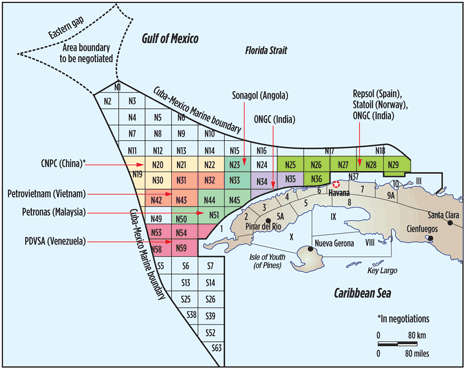 |
| Fig. 1. Exploration blocks off the west coast of Cuba, with currently leased blocks highlighted. Image courtesy Congressional Research Service. |
|
Nevertheless, to assuage these concerns, while the rig was en route to Cuba from China, where it was constructed, Repsol allowed personnel from BSEE and the Coast Guard to meet the rig in Trinidad and inspect the unit’s construction, drilling equipment, and safety systems. This included lifesaving equipment, firefighting equipment, emergency generators, dynamic positioning systems, machinery spaces and the blowout preventer. After the rig was deemed compliant, it moved along to Cuba and got to work.
The CRS said that Cuba has proven oil reserves of 100 million bbl and natural gas reserves of 2.5 Tcf, although these reserves are situated onshore or near shore. The U.S. Geological Survey estimates that the offshore North Cuba basin could contain 4.6 billion more bbl of undiscovered, but recoverable crude oil resources, as well as 900 million bbl of NGLs and 9.8 Tcf of natural gas. The CRS contends that “more than 70% of that oil may be in a portion of the North Cuba basin, from about 70 mi west of the west end of the island and stretching for about 300 mi eastward in a narrow band known as the North Cuba Foreland basin. Separately, Cuban officials claimed in 2008 that Cuban offshore resources could be as much as 20 billion bbl of undiscovered crude, but in April 2011, Cuban officials lowered those estimates to 5 to 9 billion bbl.”
Cuba imports the majority of the oil it uses, most of which is exploited for power generation and not transportation, so the island nation could certainly use more domestic production. Another positive element to a large find is that it could potentially help unshackle Cuba’s fate from the will of Venezuela, which stepped in to shepherd Cuba after the Soviet Union cut ties. As for how a significant discovery offshore Cuba could affect the U.S., that is up for debate, although it would most assuredly lead to border and economic difficulties. However, despite the fervor that the drilling of this well raised in the U.S., it is not inconceivable that the combination of a large find off Cuba and rigidly high gasoline prices in America could cause some people to reconsider the standing notion that the Eastern Gulf of Mexico should stay off-limits, although, in the current political climate, the odds do not favor that scenario.
MEETING IN THE MIDDLE
The governments of the United States and Mexico signed an agreement on Feb. 20, 2012, concerning the development of oil and gas reservoirs that cross the international maritime boundary between the two countries in the Gulf of Mexico. According to the Department of the Interior, the agreement is “designed to enhance energy security in North America and support the countries’ shared duty to exercise responsible stewardship of the Gulf of Mexico. It is built on a commitment to the safe, efficient and equitable exploitation of trans-boundary reservoirs with the highest degree of safety and environmental standards.”
This agreement has its roots in the United States and Mexico’s joint intention to negotiate a trans-boundary hydrocarbons agreement, which was announced on June 23, 2010, following a joint statement adopted by U.S. President Barack Obama and Mexican President Felipe Calderón at the conclusion of Calderon’s visit to Washington, D.C., on May 19, 2010. At that time, they agreed to extend a drilling moratorium in a zone near the continental shelf boundary, in an area of the Gulf of Mexico known as the Western Gap, Fig. 2. The moratorium, which was set to expire in January 2011, as per the Western Gap Treaty, was extended until January 2014 without prejudice to any further extension. However, upon entering into this new agreement, that moratorium has come to an end.
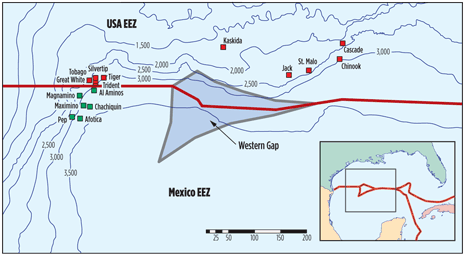 |
| Fig. 2. The U.S. and Mexican governments have come to an agreement as to how to jointly explore in the Western Gap. Image courtesy of Richard J. McLaughlin, Texas A&M – Corpus Christi. |
|
The agreement also establishes incentives for oil and gas companies to voluntarily enter into arrangements to jointly develop any reservoirs in that area. In the event such an arrangement is not achieved, the agreement establishes a process by which U.S. companies and Pemex can individually develop the resources on each side of the border, while protecting each nation’s interests and resources. The legal certainty created by the agreement will enable U.S. companies to explore new business opportunities and carry out collaborative projects with Pemex, but only in the Western Gap, for now at least.
In addition, the agreement establishes a cooperative process for managing the maritime boundary region that promotes joint utilization of trans-boundary reservoirs. It provides a legal framework for possible commercial activities at the maritime boundary and sets guidelines for trans-boundary developments.
This agreement has been a catalyst for increased engagement between oil and gas safety regulators from both countries, a relationship that each government expects to deepen in the years ahead. The agreement provides for joint inspection teams to ensure compliance with applicable laws and regulations. Both governments will review all plans for the development of any trans-boundary reservoirs.
At the signing ceremony in February, U.S. Secretary of State Hillary Clinton said, “At a time when we are working hard to both secure energy supplies and shift to more environmentally appropriate means of extracting fossil fuels, but also adding immeasurably to our search for renewable energy, this agreement is a win-win. These reservoirs could hold considerable reserves that would benefit the United States and Mexico alike.” Mexico is consistently one of the top three exporters of petroleum to the United States. In 2010, it ranked second behind only Canada with exports to the U.S. of 1.3 MMbopd.
“This agreement creates new opportunities,” Clinton stated. “And for the first time, American companies will be able to collaborate with Pemex, their Mexican counterpart. In tough times like these, we need to make the most of every opportunity to create jobs, to foster economic growth and energy security, while managing our resources and our environment responsibly for future generations.”
DON’T CALL IT A COMEBACK
With the U.S. deepwater drilling moratoria over, both the official one and the unofficial one, and permits being approved at a somewhat faster pace, drilling is returning to the Gulf of Mexico. Last year, aside from a couple of units performing workovers, the vast majority of floating rigs in the region were on standby. Today, however, according to RigStar, World Oil’s offshore rig database, there are no drillships or semisubmersibles on standby, and only a handful of floaters are stacked or preparing to work in the Gulf.
Another good sign for the region is that some of the rigs that left during the moratorium have returned, specifically Transocean drillship Discoverer Americas (Fig. 3) and semi ENSCO 8503. In addition, Hess has said that drillship Stena Forth, which also left the U.S. Gulf during the post-Macondo drilling moratorium, will return this spring to drill development wells on the Tubular Bells field.
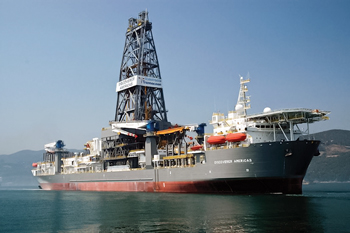 |
| Fig. 3. Transocean drillship Discoverer Americas left the Gulf during the moratorium, but has since returned and drilled successful wells for Statoil and Anadarko. Photo courtesy of Transocean. |
|
With a return to drilling come new discoveries. Of course not as many discoveries have been made in the last year as would normally occur, but that is to be expected coming out of a moratorium. That said, some strong oil and gas finds were recorded over the last 12 months.
Santiago. Noble Energy made an oil discovery at the Santiago exploration prospect in the deepwater Gulf of Mexico in May 2011, making this the first discovery since the moratorium was lifted. The well, in 6,500 ft of water on Mississippi Canyon Block 519, was drilled to a total depth of approximately 18,920 ft. Open-hole logging identified about 60 ft of oil pay in a high-quality Miocene reservoir.
Santiago is the third discovery in Noble Energy’s Galapagos project, in addition to the prior successes at Santa Cruz and Isabela. The company estimates that the total gross resources discovered in the larger Galapagos project, including the Santiago well, to be 130 MMboe. Approximately 75% of the discovered resources are oil.
“The well results were very consistent with our pre-drill expectations,” said Noble Energy’s Chairman and CEO Charles D. Davidson. He also said that the company expects all three wells at Galapagos to be online in early 2012, and it is increasing the project’s total net production impact to over 10,000 bopd.
This discovery came after Noble Energy received in late February 2011 the first drilling permit that was awarded after the deepwater moratorium was ended. Drilling at the Santiago prospect was originally suspended in June 2010, but operations resumed in early April 2011 following multiple reviews of operating and response plans, as well as third-party certifications of well designs and equipment.
Drilled using semisubmersible ENSCO 8501, the company proceeded with completion operations at Santiago, after which the rig returned to drilling on the Deep Blue prospect in Green Canyon Block 723, then an appraisal well at the Gunflint discovery in Mississippi Canyon Block 948.
Noble Energy is the operator at Santiago with a 23.25% interest. Partners in the discovery are BP (46.5%), Red Willow Offshore (20.25%) and Houston Energy (10%).
Hadrian. ExxonMobil made two major oil discoveries and a gas find in ultra-deep Hadrian prospect in the Keathley Canyon area. Recoverable volumes are estimated in excess of 700 MMboe in the Keathley Canyon blocks, making this among the biggest discoveries made in the Gulf of Mexico in the last decade. More than 85% of the resource is oil with additional upside potential.
The KC919-3 wildcat, which was drilled in spring 2011 as ExxonMobil’s first well after the moratorium, confirmed the presence of a second oil accumulation in Keathley Canyon Block 919. The well encountered more than 475 ft of net oil pay and a minor amount of gas in predominantly Pliocene, high-quality sandstone reservoirs. It was drilled using semi Maersk Developer in 7,000 ft of water, Fig. 4.
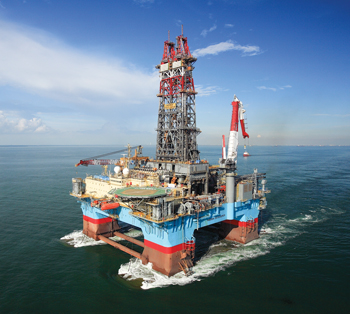 |
| Fig. 4. Semi Maersk Developer drilled the first post-Macondo well, the Hadrian discovery for ExxonMobil. Photo courtesy of ExxonMobil. |
|
Previously, during early 2010, ExxonMobil encountered oil and natural gas at Hadrian North in KC 919 and extending into KC 918, with over 550 ft of net oil pay and a minor amount of gas in high-quality Pliocene and Upper Miocene sandstone reservoirs. The company also encountered 200 ft of natural gas pay in Pliocene sandstone reservoirs at its Hadrian South prospect in KC 964 in 2009. The Hadrian discoveries are about 250 mi southwest of New Orleans in a water depth of approximately 7,000 ft.
ExxonMobil is operator of the field with a 50% working interest in all four Hadrian blocks, with the fourth block being KC 963. Petrobras holds 50% stakes in Block KC 918 and 25% in Blocks KC 919, KC 963 and KC 964. Eni holds the remaining 25% stakes in the latter three blocks.
Moccasin. Chevron also made a new oil discovery in the Keathley Canyon area of the deepwater U.S. Gulf, this time in September 2011 at the Moccasin prospect. The Keathley Canyon Block 736 Well No. 1 encountered more than 380 ft of net pay in the Lower Tertiary Wilcox sands. The well is approximately 216 mi off the Louisiana coast in 6,759 ft of water and was drilled to a depth of 31,545 ft using Transocean drillship Discoverer Inspiration.
Chevron began drilling the Moccasin well with Discoverer Inspiration back in March 2010, but, of course, the moratorium put that on hold in June 2010. Drilling resumed in March 2011. Chevron (43.75%) was the operator of the Moccasin discovery well. Other Moccasin owners are BP (43.75%) and Samson Offshore Company (12.5%).
Logan. Norwegian operator Statoil also got in on the action during the last year, striking oil in the extreme southwestern part of the Walker Ridge deepwater concession area. The discovery, named Logan, confirmed the Lower Tertiary’s potential in that area.
The discovery well, WR 969 #1, or Logan #1, intersected Paleogene sandstone, and drilling operations were completed on Oct. 22, 2011. It was drilled using Transocean drillship Discoverer Americas (Fig. 3) in a water depth of approximately 7,750 ft. The find is about 250 mi southwest of New Orleans in Walker Ridge Block 969.
Statoil operates the WR 969 consortium with a 35% stake. Petrobras holds another 35%, while Ecopetrol and Occidental hold 20% and 10%, respectively. The Logan #1 well is the first discovery in the U.S. in which Ecopetrol has participated.
VR 342. Peregrine Petroleum found oil with the VR 342 exploration well in Vermillion Block 342 in the shallow-water U.S. Gulf. The well was drilled to a TD of 8,480 ft penetrating the primary Pleistocene Lentic 1 (L1) sand target, as well as the L2 secondary target. Wireline logging and RCI analysis indicated more than 40 ft of net oil pay with an API gravity of 32˚ in the L1 sands, and an additional 10 ft in the L2 sands. Jackup Hercules 253 drilled the well in 220 ft of water.
The results matched the predicted, pre-drill estimate and provide further confidence in the gross 3P potential, established by previous drilling on the block and independently evaluated at about 7.5 million bbl of oil and 9.5 Bcf of gas.
Analogue studies performed independently on the request of then-partner Entek Energy suggested potential flowrates of 500-1,000 bopd with minimal decline for the first three to four years. Further analysis was conducted once sidewall core data had been analyzed, which is common practice in the Gulf of Mexico, where numerous existing, producing analogues give a high level of confidence.
Kinbe. Of course, not all of the activity in the Gulf of Mexico is confined to the United States. Offshore Mexico, Pemex successfully completed trial production in the Kinbe-1 exploration well, confirming the existence of a new deposit of 37°API light crude. The well is 54 mi northwest of Ciudad del Carmen, in a water depth of 72 ft. This discovery increases the oil potential of the area, which also includes the Tsimin, Xux, May and Kab Ligero Marino fields.
The Kinbe-1 well, which is Mayan for Ruta del Sol, or Sun Road, began drilling in May 2010 and ended on Aug. 9, 2011, and its average production during testing reached 5,600 bopd and 9 MMcfgd. The producing interval corresponds to the Kimmeridgian formation.
Nen. Production tests conducted by Pemex with the Nen-1 wildcat in the Mexican sector of the deepwater Gulf of Mexico confirmed the presence of a natural gas field. Preliminary estimates indicate that the field holds 3P reserves of around 400 Bcf. The well had an estimated production of 27 MMcfgd.
The Nen-1 well was drilled in the Catemaco Fold Belt, 70 mi northwest of Coatzacoalcos, Veracruz, and 28 mi east of Lakach field. Pemex drilled the well to a TD of 14,270 ft in a water depth of 4,900 ft using Grupo R semi Centenario, Fig. 5.
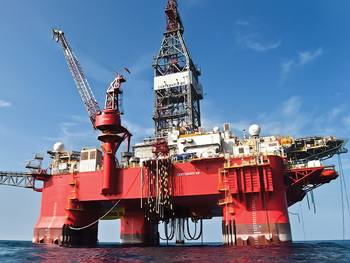 |
| Fig. 5. Grupo R semi Centenario drilled the Nen-1 deepwater discovery in 4,900 ft of water. Photo courtesy of Grupo R. |
|
The well’s objective was to obtain lithological, sedimentological and petrophysical information of the geologic column belonging to Lower and Middle Miocene age. Pemex had previously tapped this formation with the Noxal, Lalail, Leek, Lakach and Piklis gas-producing wells. The assessment derived from geophysical logs, dynamic testers and core training positively identified three sites that, together, represent a net thickness of about 164 ft of oil-impregnated sands.
Puskon. Finally, Pemex drilled yet another discovery, this time with the Puskon-1 well. The well, which was drilled 38 mi east of Tuxpan, Veracruz, proved the existence of an active petroleum system in the area. It evaluated the potential for a possible formation of Mesozoic age that, according to studies, extends over an area of about 7,725 sq mi.
Drilled in a water depth of 2,125 ft, Puskon-1 was programmed to reach a TD of 26,660 ft, but from 23,620 ft on, the presence of wet gas was confirmed. At 25,040 ft, Pemex recorded pressures and temperatures higher than predicted. Based on the rock samples and geophysical log analysis, the company identified Paleocene-age rocks 2,600 ft thick with good porosity, and two oil intervals of economic interest between 23,300 and 24,425 ft.
The company is working on characterizing the structural/stratigraphic and petrophysical information of this find in order to define its distribution and potential. Pemex is also updating its geological/geophysical interpretations in order to propose future exploration well locations to assess the potential of this oil objective while considering a design suited to the characteristics of the area.
WHAT LIES BENEATH
As with exploration work, appraisal drilling also had the kibosh put on it in the wake of the Macondo incident. However, once again, now that drilling activity is back up and running, operators are increasingly able to get back to appraising their discoveries in hopes of cashing in on their initial investments.
Heidelberg. In just this last February, Anadarko had successful results with the Heidelberg-2 appraisal in Green Canyon Block 903 in the deepwater Gulf. The well encountered approximately 250 net ft of oil pay in high-quality Miocene sands.
The appraisal well was drilled to a TD of 31,030 ft in about 5,000 ft of water, also using Discoverer Americas (Fig. 3), about 1.5 miles south and 550 ft structurally up-dip from the Heidelberg discovery. Log and pressure data from the appraisal and discovery wells indicate good-quality, continuous, pressure-connected reservoirs with the same high-quality oil. The initial Heidelberg discovery was drilled in 2009 and encountered more than 200 net ft of oil pay.
Anadarko Senior Vice President, Worldwide Exploration, Bob Daniels explained, “The successful penetration of high-quality, oil-bearing sands confirmed the continuity of the reservoir, and validated our geologic model, and initial resource estimate of more than 200 million barrels of oil. We plan to immediately sidetrack the well to evaluate the down-dip extent of the field, and plan to initiate pre-FEED (front-end engineering and design) activities to prepare for sanctioning a development project.”
Anadarko operates Block GC 903 with a 44.25% working interest. Partners in the block include Apache and Eni, each with 12.5%, Statoil (12%), and ExxonMobil and Cobalt International Energy, each with 9.375%.
Mad Dog. In September, BP announced the drilling of a successful appraisal in a previously untested northern segment of Mad Dog field. The well results confirm a resource extension for the Mad Dog complex, which includes the existing field and appraisal drilling of the Mad Dog South field that was carried out in 2008 and 2009. Pending confirmation through future appraisal drilling, the total hydrocarbons initially in place in the Mad Dog field complex are now estimated to be upwards of 4 billion boe.
The well, drilled by BHP Billiton on behalf of unit operator BP using Transocean semisubmersible GSF Development Driller I, is on Green Canyon Block 738, approximately 140 mi south of Grand Isle, Louisiana, in about 4,500 ft of water. The well encountered about 166 net ft of hydrocarbons in the objective Miocene hydrocarbon-bearing sands and discovered an oil column of more than 300 ft.
“With these additional hydrocarbon resources north of the main field, Mad Dog has been firmly established as a giant field in BP’s Gulf of Mexico portfolio, rivaling Thunder Horse in size of resource,” said Bob Dudley, BP group chief executive.
Due to the materiality of the Mad Dog South finds in 2009, BP has been advancing development options to increase production from Mad Dog by adding another spar production facility with a production capacity of 120,000 to 140,000 boepd. The Mad Dog field started production in 2005 and utilizes a truss spar platform, equipped with facilities for simultaneous production and drilling operations. The facility is designed to process 80,000 bopd and 60 Mcfgd. Oil and gas is transported to existing shelf and onshore interconnections via the Mardi Gras Transportation System.
BP maintains a 60.5% working interest in Mad Dog. BHP Billiton has a 23.9% stake and Chevron has the remaining 15.6%.
Davy Jones. The deepwater sector of the U.S. Gulf is not the only area generating considerable interest at the moment. McMoRan’s completion efforts to flow-test the Davy Jones No. 1 well on South Marsh Island Block 230 are ongoing. Although the results are not yet in as of this writing, operators and service companies, alike, are curious as to what will happen with this ultra-deep, shallow-water well. Some companies are just curious for possible future endeavors, but some have a more specific interest, including rig owner Rowan Companies, which owns the jackup testing the Davy Jones well and has a unique deal with McMoRan to be the exclusive contractor for any ultra-deep wells (below 25,000 ft) that the company drills in the Gulf of Mexico.
During initial attempts to perforate and flow-test the Wilcox F sand, the hydraulic perforating equipment malfunctioned. To expedite the test, McMoRan elected to move up-hole to test another zone using electric-line perforating equipment while future operations and plans for the F sand are evaluated. Initial testing of the Wilcox D sand, which began on March 24, 2012, saw a positive pressure response, and the company plans to add perforations in the Wilcox C sand to comingle the zones.
On March 26, McMoRan attempted to perforate the C sand. As the perforating gun was being removed from the hole, the well began to flow. When the gun was brought to the surface, it was determined that the gun did not fire in the C sand from what appears to be a simple disconnection of the detonator cord. The operator plans to use a new perforating gun to complete the testing of this sand.
Currently, the test is ongoing from only the Wilcox D sand with the produced hydrocarbons being flared off. The flow from the D sand is being affected by extensive debris in the 5-in. liner, from what McMoRan believes to be residual fluid from drilling of the well. Results of a clean test with measurable flowrates, as opposed to the current hampered test, are expected very soon.
The company hopes that, during the test, the well will flow at more than 50 MMcfgd, but, as McMoRan Co-Chairman, President and CEO James Moffett explained, no one has ever tried to produce a well with pressures in excess of 25,000 psi and temperatures greater than 400˚F. At these depths, logging and other data, which are reliable in shallower drilling, did not work. Moffett said, “McMoRan has not been able to book reserves because of the distance to other Wilcox reservoirs with reserves. We had to look 100 mi north and 200 mi south for comparable Wilcox data. Strangely enough, with all of the deepwater wells drilled in the Gulf of Mexico, only two wells have been tested from the Wilcox formation. We have had to blaze a trail and create our own analogs.”
Earlier, McMoRan drilled two successful sub-salt wells in the Davy Jones field. The Davy Jones No. 1 well logged 200 net ft of pay in multiple Wilcox sands, which were all full to base. The Davy Jones offset appraisal well, Davy Jones No. 2, which is located two and a half miles southwest of Davy Jones No. 1, confirmed 120 net ft of pay, also in multiple Wilcox sands, indicating continuity across the major structural features of the prospect. The appraisal well also encountered 192 net ft of potential hydrocarbons in the Tuscaloosa and Lower Cretaceous carbonate sections. McMoRan expects to commence completion of the No. 2 well in the second half of 2012.
Davy Jones occupies four OCS blocks covering 20,000 acres. McMoRan is the operator and holds a 63.4% working interest and a 50.2% net revenue interest. The Davy Jones partners are comprised of Energy XXI (15.8%), JX Nippon Oil Exploration (12%) and Moncrief Offshore (8.8%).
A DEVELOPING STORY
While the drilling moratorium did not halt production in the Gulf, operators could only perform workovers on their current fields, not drilling any new production wells, which obviously put a significant damper on new field developments. But, over the last year, development activity has ramped back up, both in terms of drilling and contract awards. Arguably, the most notable example from this period was Petrobras’ development of the Cascade/Chinook field, which employed the first floating production, storage and offloading vessel (FPSO) in the U.S. Gulf. World Oil has thoroughly covered that project before, but what follows are a handful of field development endeavors taking place across the region.
Big Foot. In December 2010, Chevron sanctioned development of its $4-billion Big Foot project in the deepwater U.S. Gulf of Mexico. Located approximately 225 mi south of New Orleans, in a water depth of 5,200 ft, the project is Chevron’s sixth operated facility in the deepwater Gulf of Mexico. The development will utilize a dry-tree, extended tension leg platform (ETLP) with an on-board drilling rig. It will have a production capacity of 75,000 bopd and 25 MMcfgd. Installation of the ETLP is scheduled to begin in November 2012, and first oil is expected in 2014.
Discovered in 2006, Big Foot field lies in Walker Ridge Block 29 and is estimated to contain total recoverable resources in excess of 200 million boe. Primary pay sands are Middle to Upper Miocene, ranging from 19,000 to 24,000 ft, and lying below a salt canopy ranging from 8,000 to 15,000 ft thick. Three exploration and appraisal wells with multiple sidetracks have been drilled safely and successfully in the field to define the Big Foot structure. Chevron operates the field with 60% working interest, while Statoil and Marubeni Oil & Gas are partners with 27.5% and 12.5%, respectively.
FloaTEC, a deepwater joint venture between Keppel FELS and J. Ray McDermott, is responsible for the front‐end engineering and design (FEED) of the hull, mooring and risers for the dry‐tree floating, drilling and production facility. The hull will be based on FloaTEC’s proprietary ETLP, with associated foundation piles, tendon mooring systems and top-tensioned risers. Wood Group’s Deepwater Specialists Inc. (DSI) will handle the full commissioning process of the ETLP, from development of procedures, through inspection and testing of every operational component at the South Texas fabrication yards and offshore, to the final hand-over of systems to Chevron.
KBR will provide engineering and procurement support during detailed design of the Big Foot topsides. The topsides facilities will include inlet oil and gas separation, gas compression, dehydration and export, oil treatment and export pumping, produced water treatment, water injection and all required utility systems. Meanwhile, GE Oil & Gas will supply and service the marine riser tensioner systems. GE is modifying its design to develop “push-up” style marine riser tensioner equipment to enable the ETLP to deal with the challenging wave and current movement conditions of deepwater applications.
As for the subsea equipment, Dril-Quip will supply subsea wellheads and specialty connectors and tubulars for the Big Foot ETLP. Baker Hughes will provide electrical submersible pumping (ESP) systems and production packers for seven producing wells, plus mudline packers for three injection wells. This award marks the first deployment of ESP systems inside the wellbore in the deepwater Gulf of Mexico. The systems will be placed at a TVD of approximately 16,000 ft, and deployment is scheduled to begin in 2014. In addition, 2H Offshore will be responsible for the detailed design and procurement management of the riser systems, which will comprise two high-pressure drilling risers, 15 production/water injection top-tensioned risers (TTR), and oil and gas export, steel catenary risers. The scope includes system integration, procurement and offshore installation support of the TTRs and export riser systems.
Tubular Bells. Hess Corporation announced in October that it will proceed with development of Tubular Bells, another deepwater oil and gas project in the Gulf of Mexico. Discovered in 2003, Tubular Bells is approximately 135 mi southeast of New Orleans in the Mississippi Canyon area. The field lies in water depths ranging from 4,300 to 4,600 ft.
The plan initially calls for three subsea production wells and two water injection wells from two subsea drill centers tied back to a third-party-owned spar production facility, Williams Partners’ proprietary Gulfstar FPS, Fig. 6. Drilling began earlier in 2012, and initial production is expected in 2014, subject to the receipt of necessary government permits.
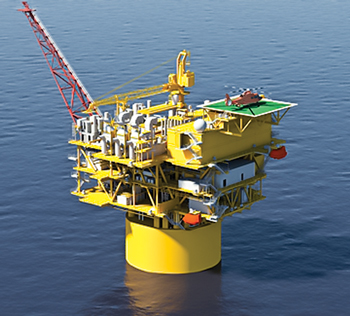 |
| Fig. 6. Hess’ Tubular Bells development will use Williams’ Gulfstar FPS, which will be the first production spar built entirely on the U.S. Gulf Coast. Image courtesy Williams Partners. |
|
Annual gross production from the field is expected to peak in the range of 40,000 to 45,000 boepd. Total estimated recoverable resources for Tubular Bells are estimated at more than 120 MMboe. The development is estimated to cost $2.3 billion, with additional commitments for production handling, export pipeline, and oil and gas gathering and processing services. Following BOEM approval of the assignment of BP’s interest, Hess holds 57.14% interest in the field, with Chevron holding the remaining 42.86%.
Williams expects Gulfstar FPS to serve as a central host facility for other deepwater prospects in the area. The company will design, construct and install the spar, which will have a total capacity of 60,000 bopd, up to 200 MMcfgd and the capability to provide seawater injection services. The production system utilizes traditional three-level topsides mated to a classic spar hull. Williams hopes that this standard design approach will allow customers to reduce their cycle time from discovery to first oil.
Gulf Marine Fabricators will construct the hull portion of the Gulfstar FPS in Corpus Christi, Texas. The topsides portion of the Gulfstar FPS will be fabricated by Alliance Engineering, which is also a Gulf Coast company, making this the first ever spar-based floating production system to be built entirely on the U.S. Gulf Coast.
Lucius. Anadarko has sanctioned development of the Lucius project, which is in the Keathley Canyon area of the deepwater U.S. Gulf. “We estimate the Lucius unit holds more than 300 MMboe with relatively shallow and highly productive reservoirs that can be developed in a capital-efficient manner,” said Anadarko President and COO Al Walker last December.
The Lucius unit includes portions of Keathley Canyon Blocks 874, 875, 918 and 919, situated 275 mi southeast of Galveston, Texas, in approximately 7,100 ft of water. Anadarko operates the unit with a 35% working interest with partners that comprise Plains E&P, ExxonMobil, Apache, Petrobras and Eni. Following the previously announced unitization agreement, Lucius interest owners entered into an agreement with the Hadrian South co-venturers, led by ExxonMobil, whereby natural gas produced from the Hadrian South field will be processed through the Lucius facility in return for a production-handling fee and reimbursement for any required facility upgrades.
The field will be developed with a truss spar floating production facility, with the capacity to produce in excess of 80,000 bopd and 450 MMcfgd. The spar is under construction by Technip at its facility in Pori, Finland, and will be the largest of Anadarko’s operated spars. FMC Technologies will provide subsea systems and life-of-field services for the project. The company’s scope-of-supply includes five subsea production trees and two manifolds. The equipment will be supplied from FMC’s operation in Houston, and deliveries are expected to begin in fourth-quarter 2012.
Mustang, another Wood Group company, has been awarded the topsides detailed engineering, procurement support and equipment inspection for the Lucius truss spar. Detailed engineering is scheduled to be completed in third-quarter 2012. Technip awarded deepwater mooring specialist First Subsea the contract to supply the mooring line connectors for the spar, which will be moored by nine Ballgrab ball-and-taper mooring connectors attached to polyester mooring lines. Aker Solutions will supply eight steel tube umbilicals for the development. The scope of work for Aker includes project management, design, engineering and manufacturing of two electro/hydraulic dynamic production umbilicals, two gas lift dynamic umbilicals, three electro/hydraulic infield umbilicals and one gas lift infield umbilical, including all associated ancillary equipment required for installation and interface with the existing development. These umbilicals will use Aker’s PVC profile matrix, which provides both predictable estimates of fatigue and friction, and improved crush and impact resistance. Final deliveries will be made in third-quarter 2013.
GA A133. It has been a quick trip for Peregrine and Entek Energy’s GA A133 development in Galveston Block 133. Discovered at only the beginning of 2011, the well was brought onstream by August. The gross hydrocarbon resource potential of GA A133 has reserves of approximately 10 Bcf of gas, with additional reserves linked to previous gas discovered on the block, which will be targeted at a later date.
The well has been completed, and gas is flowing at the planned 9.5 MMcfd on restriction. At current gas prices, Entek, with its 38% interest, is earning around $250,000 per month. The well is being produced through the GA A133 platform, Fig. 7.
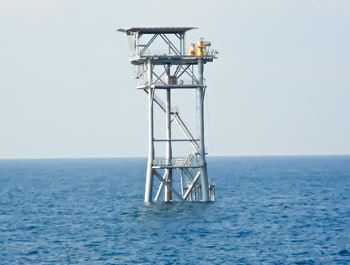 |
| Fig. 7. Peregrine’s GA A133 field was discovered and developed within 2011, using the platform shown here; not a rare occurrence in the shallow-water U.S. Gulf. Image courtesy of Entek Energy. |
|
Jack/St. Malo. In addition to the Big Foot project, Chevron is working on development of the Jack/St. Malo project, its first operated field in the Lower Tertiary trend in the deepwater U.S. Gulf. The Jack and St. Malo fields are within 25 mi of each other, approximately 280 mi south of New Orleans in water depths of about 7,000 ft. Initial development of the project will require an investment of approximately $7.5 billion, with startup anticipated in 2014. It will be comprised of three subsea centers tied back to a hub production facility, with a capacity of 170,000 bopd and 42.5 MMcfgd.
The Jack and St. Malo fields are estimated to contain combined, total recoverable resources in excess of 500 MMboe. Seven exploration and appraisal wells have been successfully drilled at these fields since 2003. Chevron has operating interests of 50% in Jack field, 51% in St. Malo field, and 50.67% in the host facility.
KBR, which is also working on the Big Foot project, will provide design and engineering support through fabrication of the deep-draft, semisubmersible floating production unit for the development, including the hull, deck box, accommodations, appurtenances, equipment foundations, mooring system design and anchor suction piles. KBR subsidiaries Granherne and GVA consultants will collaborate on the unit, which will support 33,000 tons of topside weight and act as a hub for 43 subsea wells. Once again, Chevron has contracted DSI to handle the planning, managing and field execution of the FPU commissioning. DSI’s commissioning will be performed at a South Texas fabrication yard, where the topsides will be fabricated and integrated with the hull, as well as offshore during final installation and start-up.
For this project, GE will supply three customized LM2500+G4 aeroderivative gas turbine-generator modules to provide electric power for the Jack/St. Malo FPU. Each turbine will be manufactured by GE Aero Energy in Evendale, Ohio, while the generator package assembly and testing will take place at GE Oil & Gas’ facilities in Massa, Italy. Meanwhile, MyCelx will design and deliver a produced water treatment system for the facility that will remove oil and water-soluble organics to below 10 parts per million.
As for the subsea elements of the development, Chevron awarded Cameron an order worth more than $230 million for the supply of subsea production systems for Stage I of the Jack/St. Malo venture. The project will include 12 15,000-psi subsea trees, production control systems, four manifolds and associated connection systems, engineering and project management services.
Aker Solutions was selected to supply three subsea production control umbilicals to provide hydraulic, electrical and fiber optic service to Jack and St. Malo fields. The scope of work includes three electro-hydraulic steel tube production umbilicals totaling 40 mi in length. Engineering, project management and manufacturing are taking place at Aker’s facility in Mobile, Alabama. Technip will engineer, fabricate and install more than 53 mi of 10.75-in. OD flowlines, steel catenary risers, pipeline end terminations, manifolds, pump stations and tie-in skids. Technip deepwater pipelay vessal Deep Blue will install the equipment in 2013. Additional fabrication and installation work will be carried out by McDermott, which will manufacture 21 rigid jumpers at its Morgan City facility and later install them beginning in early 2014 using the company’s subsea construction vessels North Ocean 102 and DB16. 
| Floating rig activity in the Gulf of Mexico as of March 26, 2012 |
 |
|












